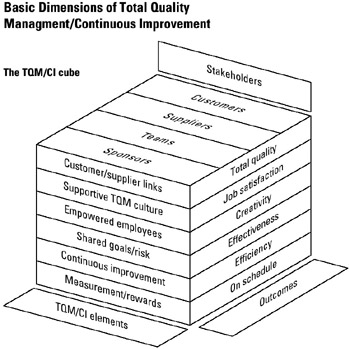Tool 68: Dimensions Cube
| AKA | N/A |
| Classification | Planning/Presenting (PP) |
Tool description
A dimension cube enables researchers to identify general dimensions of a structure, model, program, or process. It provides a means to study relationships, to estimate resource requirements, and to consider alternative action plans.
Typical application
-
To show the dimensions of something.
-
To prevent the omission of some important element from planning or investigation work.
-
To present a model of a process or concept.
Problem-solving phase
| Select and define problem or opportunity | |
| Identify and analyze causes or potential change | |
| → | Develop and plan possible solutions or change |
| → | Implement and evaluate solution or change |
| Measure and report solution or change results | |
| Recognize and reward team efforts |
Typically used by
| 1 | Research/statistics |
| Creativity/innovation | |
| Engineering | |
| Project management | |
| Manufacturing | |
| 2 | Marketing/sales |
| Administration/documentation | |
| Servicing/support | |
| 3 | Customer/quality metrics |
| Change management |
before
-
Data Collection Strategy
-
Process Analysis
-
Needs Analysis
-
Consensus Decision Making
-
Influence Diagram
after
-
Presentation
-
Bechmarking
-
Resource Requirements Matrix
-
Cluster Analysis
-
Process Selection Matrix
Notes and key points
-
Typical applications for a dimension cube:
-
Total quality concepts
-
Human resource elements
-
Basic dimensions of education
-
Human behavior modeling
-
Technology roadmaps
-
Strategic planning dimensions
-
Performance/process models
-
Step-by-step procedure
-
STEP 1 The researcher reviews the information on the topic or concept to be modeled. See example Basic Dimensions of Total Quality Management/Continuous Improvement.
-
STEP 2 Dimension headings are identified and relevant items clustered under each heading.
-
STEP 3 A dimensions cube is drawn and the items are recorded with each heading on one side of the cube as shown in the example.
-
STEP 4 The dimension cube is shown to others for additional input or revision recommendations.
-
STEP 5 The finalized dimension cube is attached to a paper or proposal as a supporting document.
Example of tool application
Basic Dimensions of Total Quality Managment/Continuous Improvement

EAN: 2147483647
Pages: 326